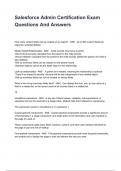Exam (elaborations)
Salesforce Admin Certification Exam Questions And Answers
- Course
- Institution
How many custom fields can be created on an object? - ANS Up to 800 custom fields per object for unlimited Edition. Master-Detail Relationships - ANS .Child records must have a parent .Record level security cascades from the parent to the child records .Record deletion cascades from the pa...
[Show more]



